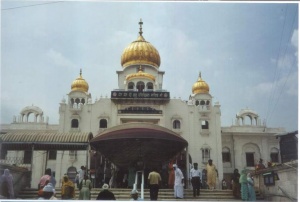Gurdwara Bangla Sahib
Gurdwara Bangla Sahib is situated in the heart of New Delhi's Connaught Place area. It is located on the east side intersection of Ashok Road and Baba Kharag Singh Marg. Originally this place was the Bungalow (haveli) of Mirza Raja Jai Singh, hence the name Bangla Sahib. It's original name was Jaisinghpura Palace. Mirza Raja Jai Singh was an important military leader of Mughal emperor Aurangzeb.
After the passing away of Guru Har Rai the seventh Sikh Guru, Ram Rai who was the eldest son of the seventh Master and his masands (masand is derived from Arabic word masnad, meaning delegating authority of the sovereign) instigated Mughal Emperor Aurangzeb to issue a decree summoning Guru Harkrishan to his court. Ram Rai was elder brother of Guru Harkrishan. Guru Harkrishan decided to go to Delhi since he felt that the "sangat", his followers had been misguided and he saw an opportunity in this to clear their misunderstandings. Meanwhile Sikhs of Delhi approached Mirza Raja Jai Singh, a strong devotee of Sikh Gurus to prevent any harm coming to Guru Harkrishan either by Aurangzeb or by the masands of Ram Rai.
Ram Rai when learned that Guru Harkrishan had accepted the summons to appear before Aurangzeb in his court at Delhi, started rejoicing since Guru Harkrishan had taken a vow not to appear before Aurangzeb. If Guru Harkrishan Comes to Delhi and refuses to meet Aurangzeb then definitely he will be arrested and suffer humiliation. Now Ram Rai felt that this act of Guru Harkrishan will surely lower his prestige among his followers and will pave the way for Ram Rai to declare himself as the true successor of Guru Har Rai.
Mirza Raja Jai Singh had made elaborate arrangements to receive Guru Harkrishan. Guru Harkrishan was received on the outskirts of Delhi like a royal guest of honor. Guru Harkrishan was accompanied by prominent Sikhs from his darbar and his mother Sulakhni.
Read full article at: banglasahib.org
Address Details
The Secretary, Management Committee, Gurdwara Bangla Sahib, Ashok Road (near Connaught Place), New Delhi Pin code 110001
Tel: 91-11-23365486, 23342871
Article from allaboutsikhs.com
A magnificent and spacious bungalow in Delhi owned by Raja Jai Singh Amber (Jaipur) who commanded great respect and honour in the court of Mughal Emperor Aurangzeb now enjoys the status of a holy shrine called Gurdwara Bangla Sahib. The eighth Guru Sri Harkishan had stayed here for a few months as guest of Raja Jai Singh. Since then it has become a place of pilgrimage for both, Hindus and Sikhs. They pay their respect to the memory of Guru Harkrishan, nominated as successor by the seventh Guru, Sri Har Rai. He passed away on October 6, 1661 A.D. When only a little over five year old, he had been tried and tested as a perfect fearless and fully illuminated soul.
Baba Ram Rai, his elder brother became much perturbed when he learnt that Har Krishan had been appointed the spiritual head. He tried in vain to influence the leading Sikhs of Delhi and Punjab. Later he approached Emperor Aurangzeb to help him acquire the Gurugadi. Consequently, Aurangzeb agreed to summon Guru Harkrishan to see whether he was really superior and more spiritual.
Fortunately both Raja Jai Singh and his son Raja Ram Singh were in Delhi at that time. When approached by Sikhs for help, they agreed to assist them in their predicament.
The Rajput chief took over the responsibility of persuading Guru Harkrishan to come to Delhi and also gained assurance from the Emperor that as long as he (the Emperor) was not satisfied about the succession issue, Guru Harkrishan would stay with him in his bungalow as guest.
During his stay in Delhi. the Guru spent most of his time in serving the humble, the sick and the destitute for cholera and smallpox were spreading in an epidemic form. He distributed medicines, food and clothes to the needy. He also directed Diwan Dargah Mal to spend all the daily offerings made by the people to the Guru for the poor. The Guru won more admirers. Soon stories about his healing powers spread throughout the city.
A small tank was constructed by Raja Jai Singh over the welL Nowadays, the faithful take home this water as amrit to cure their ailments. The Delhi Sikh Gurudwara Management Committee runs a hospital in the basement of the Gurudwara building. Besides, the Khalsa Girls School is located in the adjoining building. A tank 225 x 235 ft with 18 ft wide Parikarma and 12 ft wide varandah along its three sides has been constructed entirely with people's contnbution and voluntary labour.
The Art Gallery located in the basement of the Gurdwara is also very popular with visitors. They evince keen interest in the paintings depicting historical events connected with Sikh history. It is named after the Sikh General Sardar Bhagel Singh who supervised the construction of nine Sikh shrines in Delhi in 1783 during the time of Shah Alam II.

